Consumer Decision Making Process: A Detailed Report on Vodafone SIM
VerifiedAdded on 2023/06/05
|8
|1673
|337
Report
AI Summary
This report delves into the consumer decision-making process, using the purchase of a Vodafone SIM card as a case study. It outlines the five key steps: need recognition, information search, evaluation of alternatives, purchase decision, and post-purchase behavior. The report details the consumer's experience relocating to Australia and needing a SIM card to connect with family. It explores the internal and external sources of information used to evaluate options like Telefonica and Telstra, ultimately choosing Vodafone based on affordability, network availability, and features. The report also discusses the satisfaction derived from the purchase and how it fulfilled the consumer's needs, highlighting the importance of understanding consumer behavior in marketing and product development. Desklib provides access to similar solved assignments.
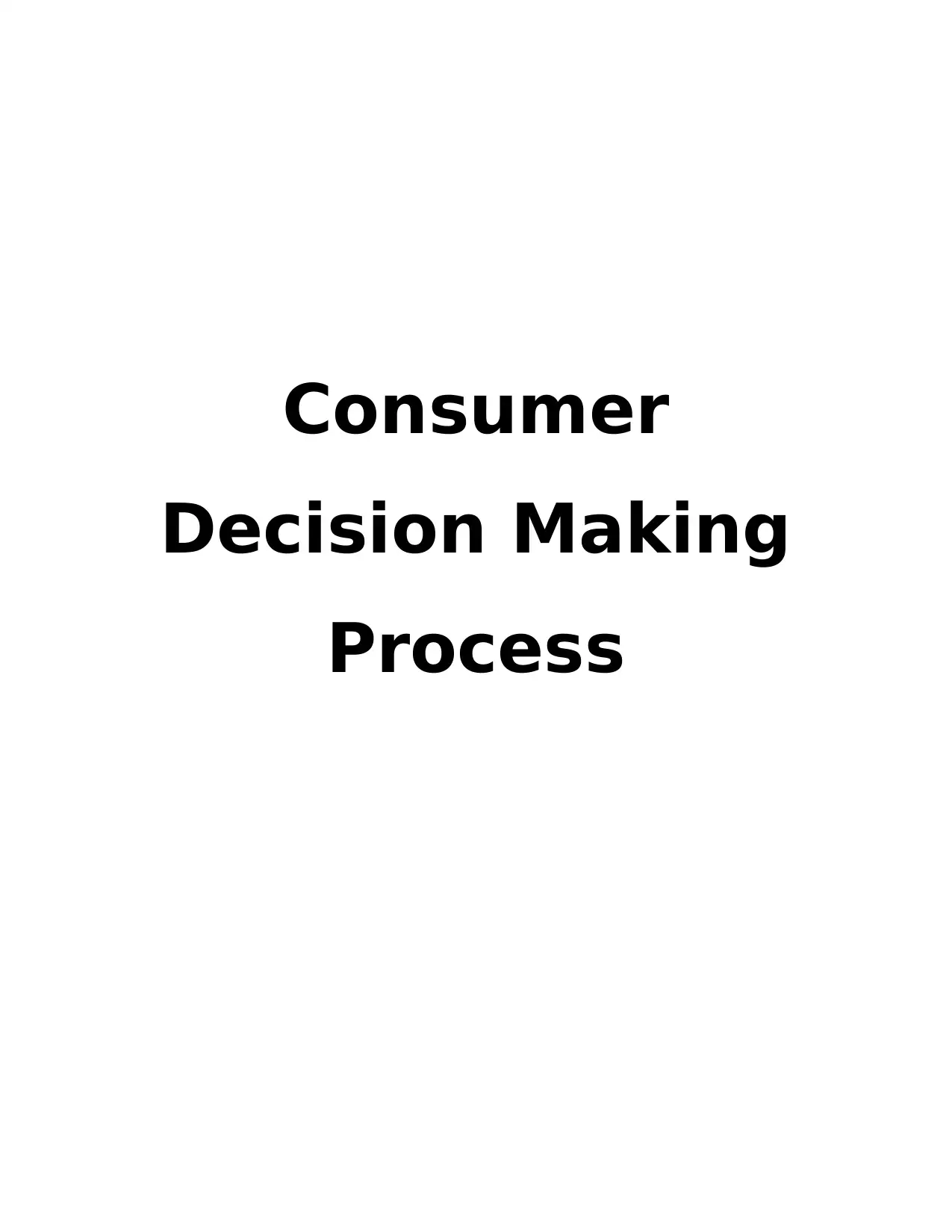
Consumer
Decision Making
Process
Decision Making
Process
Paraphrase This Document
Need a fresh take? Get an instant paraphrase of this document with our AI Paraphraser
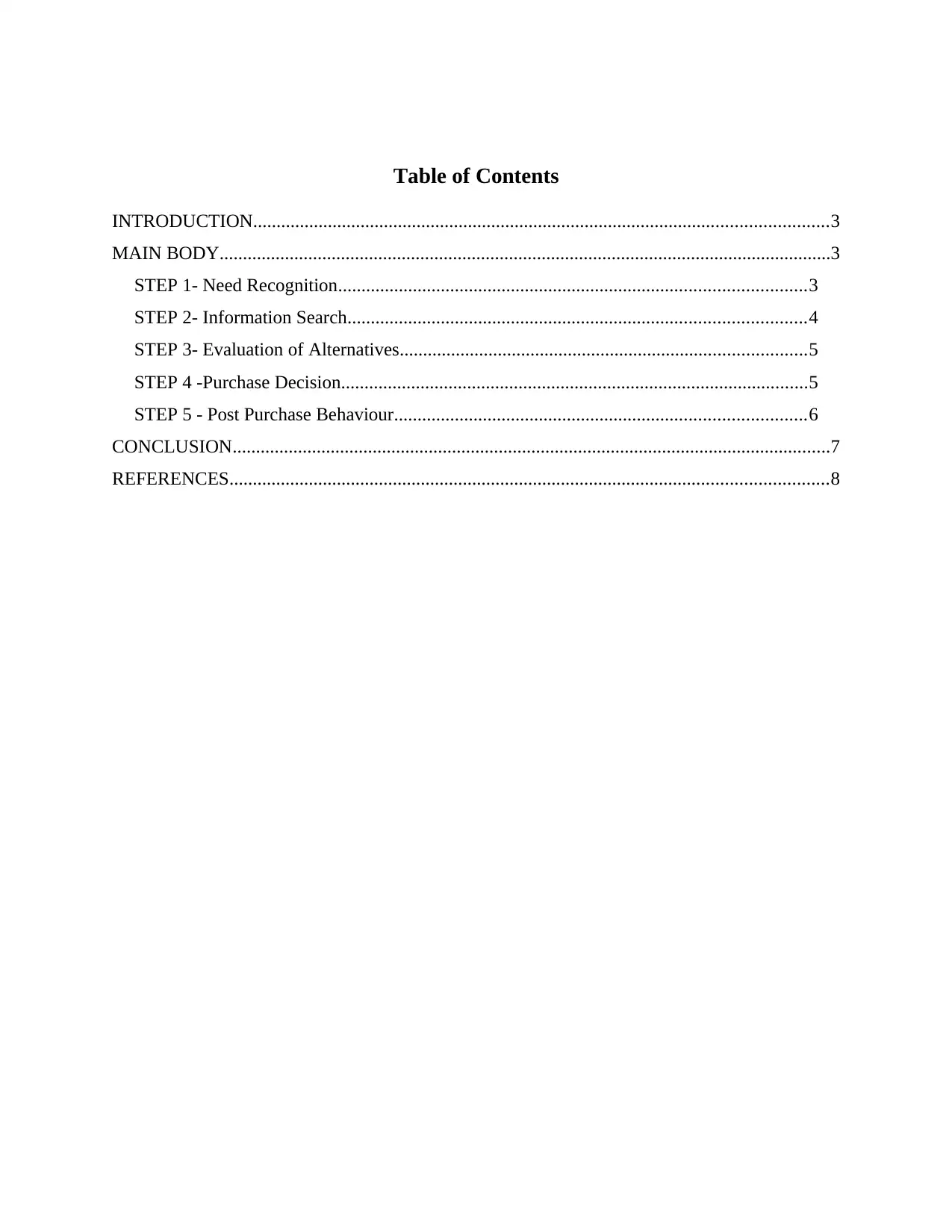
Table of Contents
INTRODUCTION...........................................................................................................................3
MAIN BODY...................................................................................................................................3
STEP 1- Need Recognition....................................................................................................3
STEP 2- Information Search..................................................................................................4
STEP 3- Evaluation of Alternatives.......................................................................................5
STEP 4 -Purchase Decision....................................................................................................5
STEP 5 - Post Purchase Behaviour........................................................................................6
CONCLUSION................................................................................................................................7
REFERENCES................................................................................................................................8
INTRODUCTION...........................................................................................................................3
MAIN BODY...................................................................................................................................3
STEP 1- Need Recognition....................................................................................................3
STEP 2- Information Search..................................................................................................4
STEP 3- Evaluation of Alternatives.......................................................................................5
STEP 4 -Purchase Decision....................................................................................................5
STEP 5 - Post Purchase Behaviour........................................................................................6
CONCLUSION................................................................................................................................7
REFERENCES................................................................................................................................8
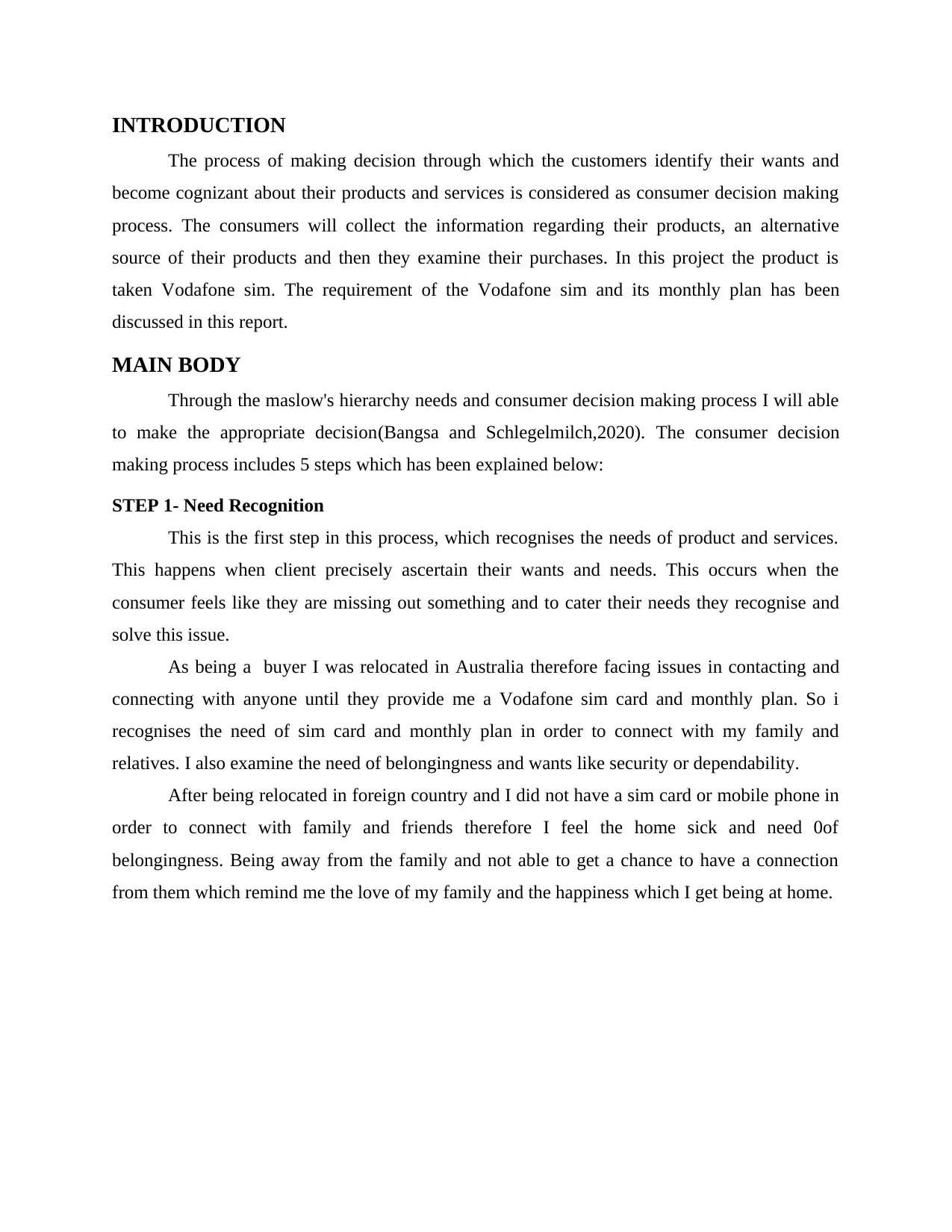
INTRODUCTION
The process of making decision through which the customers identify their wants and
become cognizant about their products and services is considered as consumer decision making
process. The consumers will collect the information regarding their products, an alternative
source of their products and then they examine their purchases. In this project the product is
taken Vodafone sim. The requirement of the Vodafone sim and its monthly plan has been
discussed in this report.
MAIN BODY
Through the maslow's hierarchy needs and consumer decision making process I will able
to make the appropriate decision(Bangsa and Schlegelmilch,2020). The consumer decision
making process includes 5 steps which has been explained below:
STEP 1- Need Recognition
This is the first step in this process, which recognises the needs of product and services.
This happens when client precisely ascertain their wants and needs. This occurs when the
consumer feels like they are missing out something and to cater their needs they recognise and
solve this issue.
As being a buyer I was relocated in Australia therefore facing issues in contacting and
connecting with anyone until they provide me a Vodafone sim card and monthly plan. So i
recognises the need of sim card and monthly plan in order to connect with my family and
relatives. I also examine the need of belongingness and wants like security or dependability.
After being relocated in foreign country and I did not have a sim card or mobile phone in
order to connect with family and friends therefore I feel the home sick and need 0of
belongingness. Being away from the family and not able to get a chance to have a connection
from them which remind me the love of my family and the happiness which I get being at home.
The process of making decision through which the customers identify their wants and
become cognizant about their products and services is considered as consumer decision making
process. The consumers will collect the information regarding their products, an alternative
source of their products and then they examine their purchases. In this project the product is
taken Vodafone sim. The requirement of the Vodafone sim and its monthly plan has been
discussed in this report.
MAIN BODY
Through the maslow's hierarchy needs and consumer decision making process I will able
to make the appropriate decision(Bangsa and Schlegelmilch,2020). The consumer decision
making process includes 5 steps which has been explained below:
STEP 1- Need Recognition
This is the first step in this process, which recognises the needs of product and services.
This happens when client precisely ascertain their wants and needs. This occurs when the
consumer feels like they are missing out something and to cater their needs they recognise and
solve this issue.
As being a buyer I was relocated in Australia therefore facing issues in contacting and
connecting with anyone until they provide me a Vodafone sim card and monthly plan. So i
recognises the need of sim card and monthly plan in order to connect with my family and
relatives. I also examine the need of belongingness and wants like security or dependability.
After being relocated in foreign country and I did not have a sim card or mobile phone in
order to connect with family and friends therefore I feel the home sick and need 0of
belongingness. Being away from the family and not able to get a chance to have a connection
from them which remind me the love of my family and the happiness which I get being at home.
⊘ This is a preview!⊘
Do you want full access?
Subscribe today to unlock all pages.

Trusted by 1+ million students worldwide
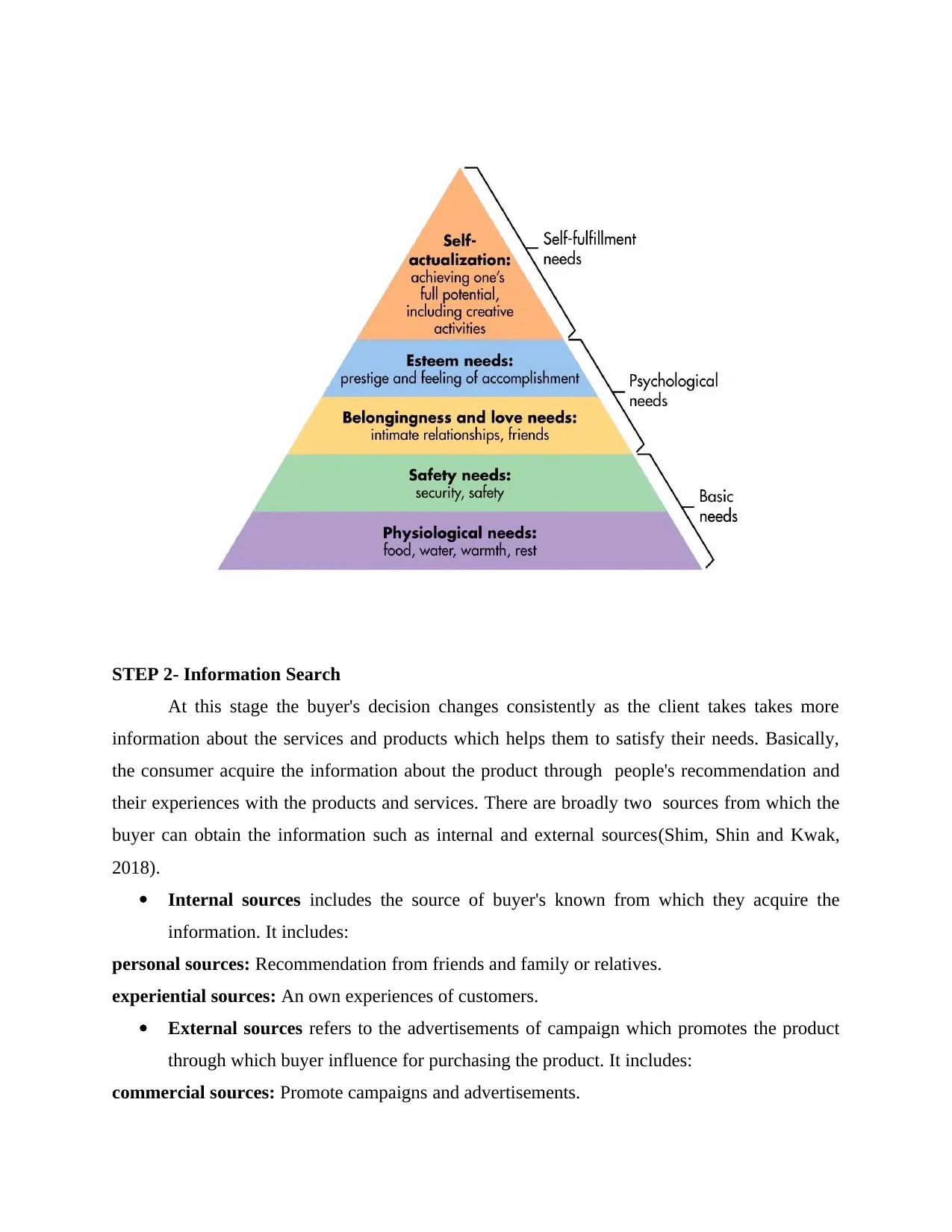
STEP 2- Information Search
At this stage the buyer's decision changes consistently as the client takes takes more
information about the services and products which helps them to satisfy their needs. Basically,
the consumer acquire the information about the product through people's recommendation and
their experiences with the products and services. There are broadly two sources from which the
buyer can obtain the information such as internal and external sources(Shim, Shin and Kwak,
2018).
Internal sources includes the source of buyer's known from which they acquire the
information. It includes:
personal sources: Recommendation from friends and family or relatives.
experiential sources: An own experiences of customers.
External sources refers to the advertisements of campaign which promotes the product
through which buyer influence for purchasing the product. It includes:
commercial sources: Promote campaigns and advertisements.
At this stage the buyer's decision changes consistently as the client takes takes more
information about the services and products which helps them to satisfy their needs. Basically,
the consumer acquire the information about the product through people's recommendation and
their experiences with the products and services. There are broadly two sources from which the
buyer can obtain the information such as internal and external sources(Shim, Shin and Kwak,
2018).
Internal sources includes the source of buyer's known from which they acquire the
information. It includes:
personal sources: Recommendation from friends and family or relatives.
experiential sources: An own experiences of customers.
External sources refers to the advertisements of campaign which promotes the product
through which buyer influence for purchasing the product. It includes:
commercial sources: Promote campaigns and advertisements.
Paraphrase This Document
Need a fresh take? Get an instant paraphrase of this document with our AI Paraphraser
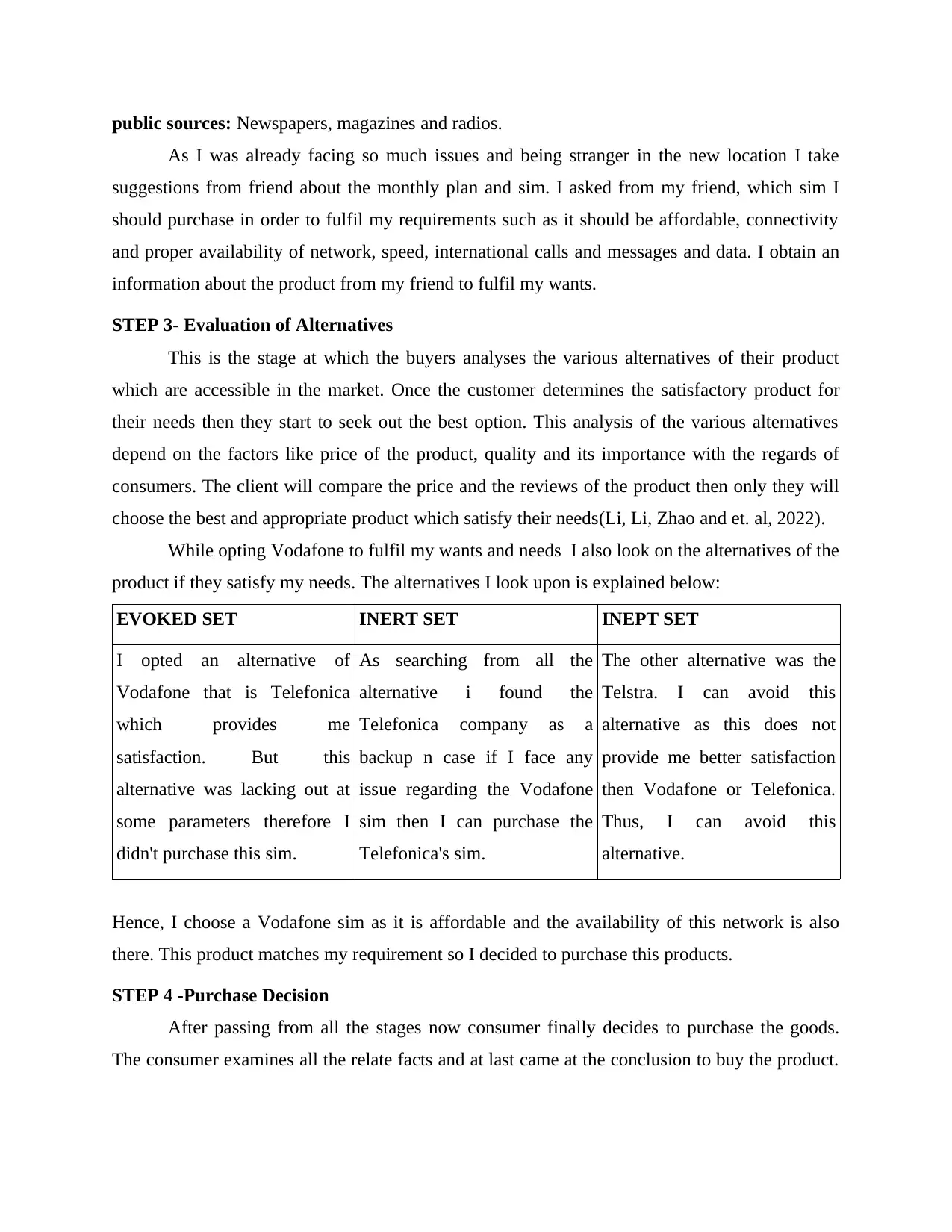
public sources: Newspapers, magazines and radios.
As I was already facing so much issues and being stranger in the new location I take
suggestions from friend about the monthly plan and sim. I asked from my friend, which sim I
should purchase in order to fulfil my requirements such as it should be affordable, connectivity
and proper availability of network, speed, international calls and messages and data. I obtain an
information about the product from my friend to fulfil my wants.
STEP 3- Evaluation of Alternatives
This is the stage at which the buyers analyses the various alternatives of their product
which are accessible in the market. Once the customer determines the satisfactory product for
their needs then they start to seek out the best option. This analysis of the various alternatives
depend on the factors like price of the product, quality and its importance with the regards of
consumers. The client will compare the price and the reviews of the product then only they will
choose the best and appropriate product which satisfy their needs(Li, Li, Zhao and et. al, 2022).
While opting Vodafone to fulfil my wants and needs I also look on the alternatives of the
product if they satisfy my needs. The alternatives I look upon is explained below:
EVOKED SET INERT SET INEPT SET
I opted an alternative of
Vodafone that is Telefonica
which provides me
satisfaction. But this
alternative was lacking out at
some parameters therefore I
didn't purchase this sim.
As searching from all the
alternative i found the
Telefonica company as a
backup n case if I face any
issue regarding the Vodafone
sim then I can purchase the
Telefonica's sim.
The other alternative was the
Telstra. I can avoid this
alternative as this does not
provide me better satisfaction
then Vodafone or Telefonica.
Thus, I can avoid this
alternative.
Hence, I choose a Vodafone sim as it is affordable and the availability of this network is also
there. This product matches my requirement so I decided to purchase this products.
STEP 4 -Purchase Decision
After passing from all the stages now consumer finally decides to purchase the goods.
The consumer examines all the relate facts and at last came at the conclusion to buy the product.
As I was already facing so much issues and being stranger in the new location I take
suggestions from friend about the monthly plan and sim. I asked from my friend, which sim I
should purchase in order to fulfil my requirements such as it should be affordable, connectivity
and proper availability of network, speed, international calls and messages and data. I obtain an
information about the product from my friend to fulfil my wants.
STEP 3- Evaluation of Alternatives
This is the stage at which the buyers analyses the various alternatives of their product
which are accessible in the market. Once the customer determines the satisfactory product for
their needs then they start to seek out the best option. This analysis of the various alternatives
depend on the factors like price of the product, quality and its importance with the regards of
consumers. The client will compare the price and the reviews of the product then only they will
choose the best and appropriate product which satisfy their needs(Li, Li, Zhao and et. al, 2022).
While opting Vodafone to fulfil my wants and needs I also look on the alternatives of the
product if they satisfy my needs. The alternatives I look upon is explained below:
EVOKED SET INERT SET INEPT SET
I opted an alternative of
Vodafone that is Telefonica
which provides me
satisfaction. But this
alternative was lacking out at
some parameters therefore I
didn't purchase this sim.
As searching from all the
alternative i found the
Telefonica company as a
backup n case if I face any
issue regarding the Vodafone
sim then I can purchase the
Telefonica's sim.
The other alternative was the
Telstra. I can avoid this
alternative as this does not
provide me better satisfaction
then Vodafone or Telefonica.
Thus, I can avoid this
alternative.
Hence, I choose a Vodafone sim as it is affordable and the availability of this network is also
there. This product matches my requirement so I decided to purchase this products.
STEP 4 -Purchase Decision
After passing from all the stages now consumer finally decides to purchase the goods.
The consumer examines all the relate facts and at last came at the conclusion to buy the product.
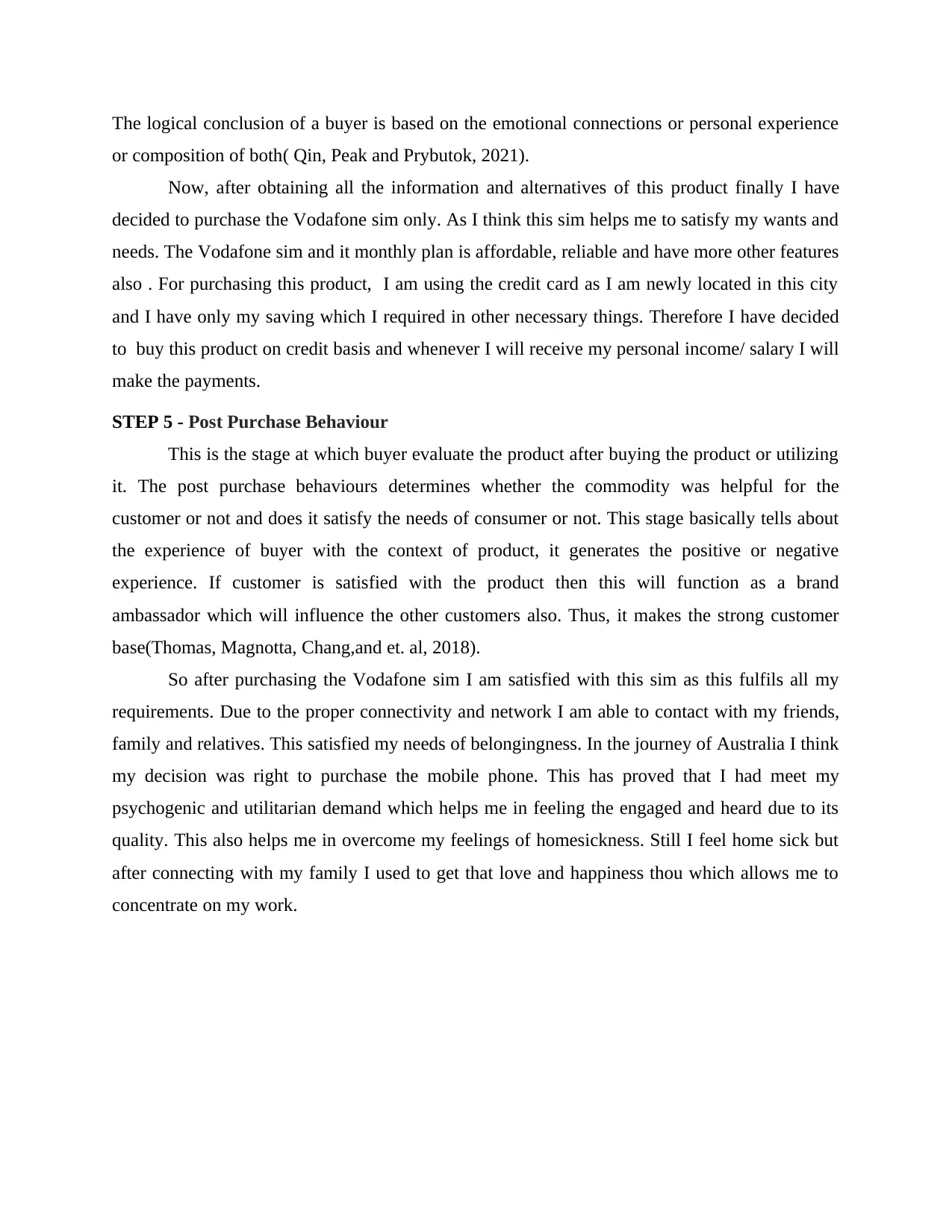
The logical conclusion of a buyer is based on the emotional connections or personal experience
or composition of both( Qin, Peak and Prybutok, 2021).
Now, after obtaining all the information and alternatives of this product finally I have
decided to purchase the Vodafone sim only. As I think this sim helps me to satisfy my wants and
needs. The Vodafone sim and it monthly plan is affordable, reliable and have more other features
also . For purchasing this product, I am using the credit card as I am newly located in this city
and I have only my saving which I required in other necessary things. Therefore I have decided
to buy this product on credit basis and whenever I will receive my personal income/ salary I will
make the payments.
STEP 5 - Post Purchase Behaviour
This is the stage at which buyer evaluate the product after buying the product or utilizing
it. The post purchase behaviours determines whether the commodity was helpful for the
customer or not and does it satisfy the needs of consumer or not. This stage basically tells about
the experience of buyer with the context of product, it generates the positive or negative
experience. If customer is satisfied with the product then this will function as a brand
ambassador which will influence the other customers also. Thus, it makes the strong customer
base(Thomas, Magnotta, Chang,and et. al, 2018).
So after purchasing the Vodafone sim I am satisfied with this sim as this fulfils all my
requirements. Due to the proper connectivity and network I am able to contact with my friends,
family and relatives. This satisfied my needs of belongingness. In the journey of Australia I think
my decision was right to purchase the mobile phone. This has proved that I had meet my
psychogenic and utilitarian demand which helps me in feeling the engaged and heard due to its
quality. This also helps me in overcome my feelings of homesickness. Still I feel home sick but
after connecting with my family I used to get that love and happiness thou which allows me to
concentrate on my work.
or composition of both( Qin, Peak and Prybutok, 2021).
Now, after obtaining all the information and alternatives of this product finally I have
decided to purchase the Vodafone sim only. As I think this sim helps me to satisfy my wants and
needs. The Vodafone sim and it monthly plan is affordable, reliable and have more other features
also . For purchasing this product, I am using the credit card as I am newly located in this city
and I have only my saving which I required in other necessary things. Therefore I have decided
to buy this product on credit basis and whenever I will receive my personal income/ salary I will
make the payments.
STEP 5 - Post Purchase Behaviour
This is the stage at which buyer evaluate the product after buying the product or utilizing
it. The post purchase behaviours determines whether the commodity was helpful for the
customer or not and does it satisfy the needs of consumer or not. This stage basically tells about
the experience of buyer with the context of product, it generates the positive or negative
experience. If customer is satisfied with the product then this will function as a brand
ambassador which will influence the other customers also. Thus, it makes the strong customer
base(Thomas, Magnotta, Chang,and et. al, 2018).
So after purchasing the Vodafone sim I am satisfied with this sim as this fulfils all my
requirements. Due to the proper connectivity and network I am able to contact with my friends,
family and relatives. This satisfied my needs of belongingness. In the journey of Australia I think
my decision was right to purchase the mobile phone. This has proved that I had meet my
psychogenic and utilitarian demand which helps me in feeling the engaged and heard due to its
quality. This also helps me in overcome my feelings of homesickness. Still I feel home sick but
after connecting with my family I used to get that love and happiness thou which allows me to
concentrate on my work.
⊘ This is a preview!⊘
Do you want full access?
Subscribe today to unlock all pages.

Trusted by 1+ million students worldwide
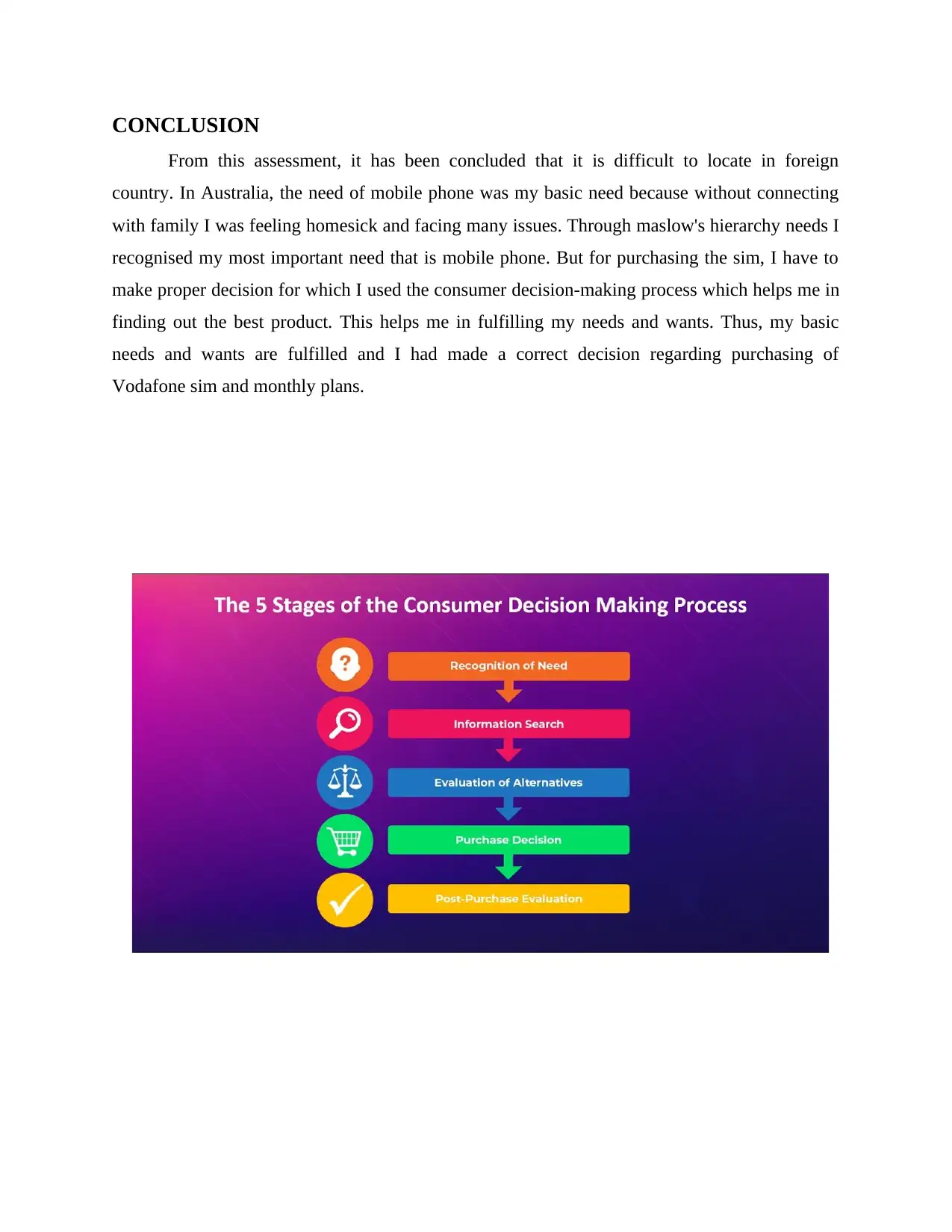
CONCLUSION
From this assessment, it has been concluded that it is difficult to locate in foreign
country. In Australia, the need of mobile phone was my basic need because without connecting
with family I was feeling homesick and facing many issues. Through maslow's hierarchy needs I
recognised my most important need that is mobile phone. But for purchasing the sim, I have to
make proper decision for which I used the consumer decision-making process which helps me in
finding out the best product. This helps me in fulfilling my needs and wants. Thus, my basic
needs and wants are fulfilled and I had made a correct decision regarding purchasing of
Vodafone sim and monthly plans.
From this assessment, it has been concluded that it is difficult to locate in foreign
country. In Australia, the need of mobile phone was my basic need because without connecting
with family I was feeling homesick and facing many issues. Through maslow's hierarchy needs I
recognised my most important need that is mobile phone. But for purchasing the sim, I have to
make proper decision for which I used the consumer decision-making process which helps me in
finding out the best product. This helps me in fulfilling my needs and wants. Thus, my basic
needs and wants are fulfilled and I had made a correct decision regarding purchasing of
Vodafone sim and monthly plans.
Paraphrase This Document
Need a fresh take? Get an instant paraphrase of this document with our AI Paraphraser
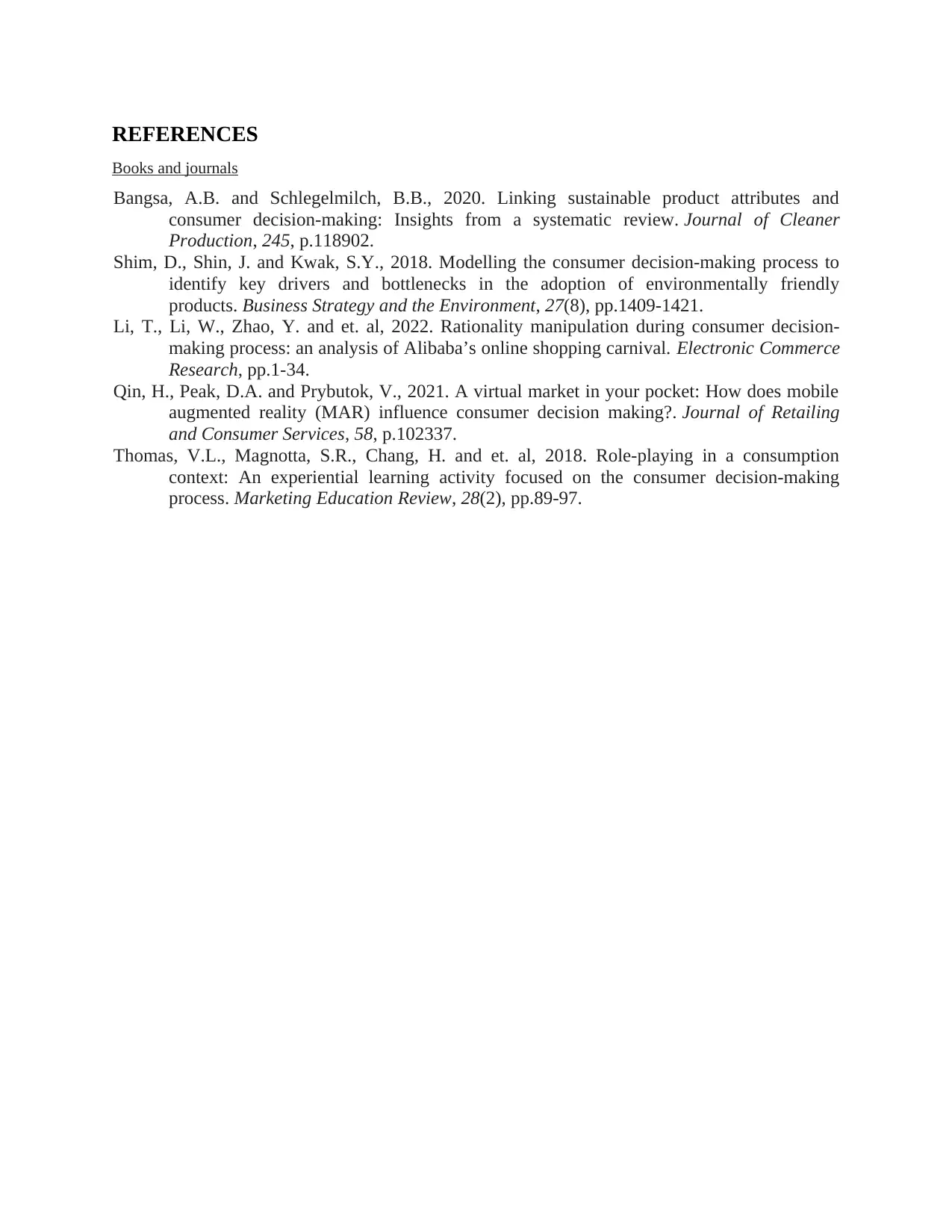
REFERENCES
Books and journals
Bangsa, A.B. and Schlegelmilch, B.B., 2020. Linking sustainable product attributes and
consumer decision-making: Insights from a systematic review. Journal of Cleaner
Production, 245, p.118902.
Shim, D., Shin, J. and Kwak, S.Y., 2018. Modelling the consumer decision‐making process to
identify key drivers and bottlenecks in the adoption of environmentally friendly
products. Business Strategy and the Environment, 27(8), pp.1409-1421.
Li, T., Li, W., Zhao, Y. and et. al, 2022. Rationality manipulation during consumer decision-
making process: an analysis of Alibaba’s online shopping carnival. Electronic Commerce
Research, pp.1-34.
Qin, H., Peak, D.A. and Prybutok, V., 2021. A virtual market in your pocket: How does mobile
augmented reality (MAR) influence consumer decision making?. Journal of Retailing
and Consumer Services, 58, p.102337.
Thomas, V.L., Magnotta, S.R., Chang, H. and et. al, 2018. Role-playing in a consumption
context: An experiential learning activity focused on the consumer decision-making
process. Marketing Education Review, 28(2), pp.89-97.
Books and journals
Bangsa, A.B. and Schlegelmilch, B.B., 2020. Linking sustainable product attributes and
consumer decision-making: Insights from a systematic review. Journal of Cleaner
Production, 245, p.118902.
Shim, D., Shin, J. and Kwak, S.Y., 2018. Modelling the consumer decision‐making process to
identify key drivers and bottlenecks in the adoption of environmentally friendly
products. Business Strategy and the Environment, 27(8), pp.1409-1421.
Li, T., Li, W., Zhao, Y. and et. al, 2022. Rationality manipulation during consumer decision-
making process: an analysis of Alibaba’s online shopping carnival. Electronic Commerce
Research, pp.1-34.
Qin, H., Peak, D.A. and Prybutok, V., 2021. A virtual market in your pocket: How does mobile
augmented reality (MAR) influence consumer decision making?. Journal of Retailing
and Consumer Services, 58, p.102337.
Thomas, V.L., Magnotta, S.R., Chang, H. and et. al, 2018. Role-playing in a consumption
context: An experiential learning activity focused on the consumer decision-making
process. Marketing Education Review, 28(2), pp.89-97.
1 out of 8
Related Documents
Your All-in-One AI-Powered Toolkit for Academic Success.
+13062052269
info@desklib.com
Available 24*7 on WhatsApp / Email
![[object Object]](/_next/static/media/star-bottom.7253800d.svg)
Unlock your academic potential
Copyright © 2020–2025 A2Z Services. All Rights Reserved. Developed and managed by ZUCOL.





